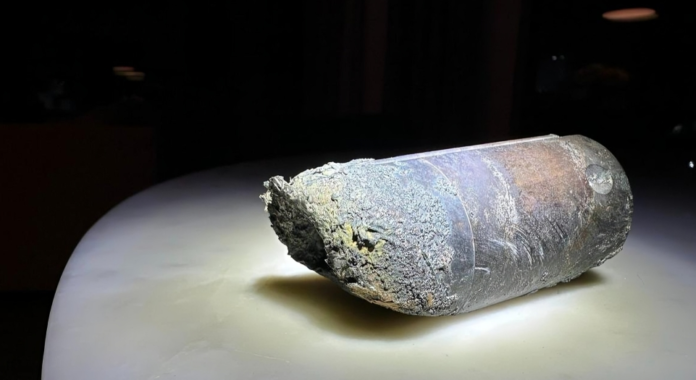NAPLES, Fla. — What should have been a laidback escape turned into a harrowing drama for Alejandro Otero when a hunk of extraterrestrial debris went slicing through his Naples, Florida digs on March 8th. The two-pound cylindrical gizmo, suspected to be part of a discarded battery pallet from the International Space Station, barreled through the roof and two floors before at last grinding to a halt, just rooms away from where Mr. Otero’s offspring was posted up.
“It was a ruckus like I’ve never heard before, an absolute humdinger,” Otero recounted, still sounding shellshocked. “Something ripped clean through the house leaving craters in the floor and ceiling. If my kid had been just a couple rooms over, well, I don’t even want to go there.”
The incident sparked national rubbernecking and stoked concerns over the mounting threat of space trash as more and more widgets get rocketed into Earth’s orbits. NASA is probing the cylindrical chunk’s origins, but many eggheads believe it’s likely fallout from a battery pallet that was jettisoned from the International Space Station back in 2021.
“Considering the size, shape, and predicted re-entry window, there’s a high probability this piece of cosmic litter came from that battery pallet they tossed a few years back,” said Jonathan McDowell, a stargazer at the Harvard-Smithsonian Center for Astrophysics. “While most of it would have burned up on re-entry, we forecast around half a ton of fragments could possibly survive and wallop the ground.”
The pallet in question was used to temporarily stash old batteries during a 2021 upgrade to one of the space station’s power channels. Tipping the scales at nearly three tons, it was the most colossal single object ever pitched from the ISS according to NASA. The agency predicted it would make an “uncontrolled re-entry” back into Earth’s atmosphere sometime between March 7-9 of this year.
While the re-entry of larger space objects is no anomaly, with one estimated to occur naturally about once per week, this incident underlines the risks posed by Earth’s increasingly congested orbits. As more satellites, rockets, and other spacecraft get launched, the amount of debris keeps piling ever higher, making impacts like the one at the Otero household progressively more probable.
“Uncontrolled re-entries are an inevitable reality as space exploration ramps up,” a European Space Agency spokesperson stated. “While the overall risk of casualties is extremely low, we can’t completely eliminate the possibility of property damage or injuries as this case vividly illustrates.”
For the Oteros, the incident was an unwanted and shockingly costly add-on to their planned vacay. Beyond the gaping skylights newly punched in their roof and floors, the debris also wrought substantial havoc on the home’s interior.
“The whole place was submerged in dust and insulation. We had to redo the drywall, flooring, the whole nine yards,” Otero explained, still sounding exasperated. “Not exactly how I envisioned spending my vacation, that’s for darn sure.”
Otero voiced frustrations with the lack of response from NASA following the close call. After leaving messages and emails with no reply, he finally got the agency’s attention by splashing photos of the wreckage on social media.
To the Otero family’s chagrin, determining liability and securing compensation may well prove a convoluted quagmire. While NASA owned the batteries, the pallet itself was built and launched by the Japanese Aerospace Exploration Agency (JAXA) several years prior as part of the international cooperative that supplies and operates the ISS.
“At this stage, we’re just kicking rocks waiting to hear back from the investigation,” Otero said, sounding increasingly peeved. “I know space programs involve some risk, but I didn’t expect it to literally crash land in my living room. The least they could do is work with us on covering the repairs.”
As for the road ahead, experts emphasize the significance of developing sharper tracking systems and disposal techniques to wrangle the growing space debris dilemma. Some pitch deploying collector vehicles to systematically remove defunct satellites and equipment already cluttering orbits.
Others trumpet stricter regulations and international policies around preventing new debris accumulation through proper spacecraft and launch vehicle design. Without such measures, the nightmarish experience of the Oteros may only become more common on Earth’s surface in the years ahead.
“This was a rude awakening, a real cosmic wake-up call,” said Dr. McDowell. “The challenges of orbital debris are catching up to us in a major way. If we don’t get a handle on the issue soon, ‘space dust’ may start taking on a much more literal, dangerous meaning for all of us groundlings.”





















